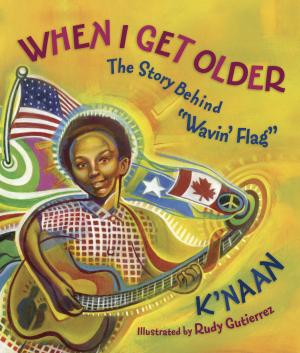
When I Get Older: The Story Behind “Wavin’ Flag”
K’naan, who immigrated to Toronto from Mogadishu, Somalia, in 1991, is a talented musician who raises social and economic issues through his songs. He has recently released a beautifully written and illustrated story, Wavin’ Flag, the same title as his hit song. This book tells his story of life as a refugee in a child-friendly manner. In Wavin’ Flag, K’naan shares how the wise words of his grandfather, “When I get older, I will be stronger, They’ll call me freedom, just like a waving flag,” got him through the struggles of living through war, immigrating to a new country, learning a new language, and being teased and bullied. The key role of music in K’naan’s life now, and as a child, is evident. This story shares how he depended on music as it provided something for him to love, gave him a way to connect with other kids in school, and helped him feel safe. The music and lyrics to “Wavin’ Flag” are printed at the end of the book along with a brief history of Somalia.
This book could be used as a read-aloud in all divisions across many curriculum areas such as language and the arts. We ask students to make connections to self and the world, and this text gives refugees and immigrants in our schools a story they can relate to. K’naan built a song around his grandfather’s poem. As a cross-curricular extension to a poetry unit, students could work in groups to write their own songs using their poetry as a starting point. The artwork in the book could easily be used to teach the visual arts expectations of reflecting, responding and analyzing. Students could then create their own artworks using mixed media to create a CD cover for their song.
To extend “current/global issues” discussions, older students could research Somalia and other countries with similar struggles. After their research is shared, students could work in groups to complete Venn diagrams to compare/contrast the information. A connection to social studies/history could be made by having students include their knowledge of the conditions in some Aboriginal communities in Canada into the Venn diagram activity. This book would also be a great tool when teaching the character education attributes of respect, perseverance, courage, integrity, and optimism.
Teachers using ETFO’s Social Justice Begins with Me resource, will be able to use this book as an extension to the themes of Sharing Our Lives, Peace, Building Supportive Communities, Rights of the Child, Untie the Knots of Prejudice, and Circles and Cycles.
Jill Aoki-Barrett is a member of the Niagara Teacher Local.